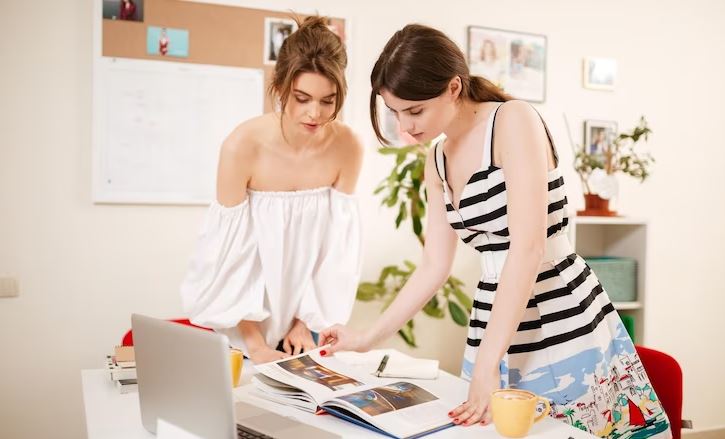People who work in the fashion industry are imaginative. They commit themselves fully to conceptualizing novel designs and implementing those plans. They have received widespread acclaim for their contributions as genuine artists in their field.
It is not uncommon to wish to get in touch with a working fashion designer for help with things like research papers and career exploration. You may need to contact them to place a particular order. Getting in touch with a fashion designer is easy since many options exist.
Look For Someone With A Production Background
If a designer does not have this, they likely have yet to learn how to assemble a garment. A designer may make mistakes with the design and quality of the garment if they lack expertise in retail and production. It also suggests that the designer would not provide the garments or a tech bundle in addition to the designs.
It is great for a designer’s career if they win accolades and prizes, but you should put only a little stock on them. Even if the designer is very talented, having manufacturing knowledge is essential for mass-producing clothing. Choose the best fashion designing course in Jaipur.
Use Only Professional Fashion Designers
When first getting started in the fashion industry, finding a dedicated employee is essential. There is a lot to accomplish in the beginning stages of a firm. Bringing in freelancers isn’t a good idea when one can only manage some things independently. As a result, it is wise to employ a competent fashion designer full-time.
A clothes designer’s duties are
A clothes designer’s key responsibilities include the following:
Motivating Factor
Before beginning the design process, they may first perform market research to monitor industry trends and learn more about what consumers want. They may talk to the store’s retail or sales staff and do market research. They also make mood boards and gather imagery to help them design better and more accurately reflect the concept.
Manage The Factory Floor
After sketching and choosing materials, fashion designers observe that their creations are made. They collaborate with building designers, who use the blueprints to figure out how to make a working model. To ensure the final product is stylish and well-made, they may advise on how to sew specific design components.
Clothing patterns are templates containing cutting and sewing instructions printed on thin tissue paper, and patternmakers utilize prototypes to generate these patterns. Factories and sewists use patterns to ensure that each garment is constructed similarly when the fabric is cut and sewn. Depending on the company’s demands, patternmakers may alter some features of the materials to facilitate the design’s mass production in factories. Designers must have a firm grasp of building, pattern making, and sewing if they ever have to execute these things independently.
The Abilities of a Fashion Designer
Innovative thinking: you need to be able to come up with new product concepts.
Creative skill: a designer should be able to take a concept and render it visually, then build a prototype from which to create the final product. You will also benefit from an eye for colour and design.
Designers often collaborate. Therefore, effective communication is essential.
Training
When first starting, many aspiring fashion designers intern for either established fashion houses or work for established designers as assistants. Interns in the design industry typically work for the company’s design division, but designers may also explore working in other areas of the business. They may learn about the role of a fashion designer in a business setting via this internship. They may also gain knowledge by seeing other designers, talking to suppliers, and labelling their designs.
Interns in the fashion industry may get valuable experience by shadowing a small independent designer and learning how various business structures impact a designer’s day-to-day operations. Since many independent fashion designers also outsource their sewing and patternmaking, this might offer them additional responsibility and exposure to the industry.
Optimism About The Job Market
Bureau of Labor Statistics predicts a slower-than-average growth outlook for fashion designers seeking to work with apparel manufacturers over the next decade. However, a 22% increase is expected for fashion designer positions in the retail sector.
In the decade from 2016 to 2026, the employment of fashion designers is predicted to expand by just approximately 3%, far less than the average projection for all professions. These rates are much higher than the predicted 7% growth for all professions. The ratio of available jobs to applicants is relatively high, making competition fierce.
Situation at Work
The fashion industry is highly concentrated in New York and California, and most fashion designers work for wholesalers or garment manufacturers that make apparel and accessory products for shops. High-fashion products, custom-made or one-of-a-kind apparel, and for specific designers, a line of clothing branded with their name are all common outputs for self-employed fashion designers that work from home.
- Leading the creative process from initial idea to finished product.
- Finding new materials and methods and gaining creative inspiration via market research.
- Working together to decide on seasonal themes, revise the line, and develop new ideas.
- Making sure the product fits in with the overall company plan.
- Fabric and trim choices.
- We are producing development package production drawings.
- We are working with the technical designer to check the accuracy of the development packages.
- During the presentation, we checked the product for fit and aesthetics.
- Sharing concept, mood, and colour boards with purchasers.
Designing Fashion: Different Genres
- Different kinds of fashion designers specialize in various aspects of the industry. Some categories of fashion designers are as follows:
- Designer of Exquisite Threads: High-end, custom-made clothing is what haute couture designers specialize in making. They only use the most talented artisans and utilize the highest quality materials in their creations.
- Fashion designers specialising in ready-to-wear usually develop items mass-produced in conventional sizes and sold in department shops. They take into account things like price and demand while creating apparel that is both stylish and practical.
- Sportswear designers make activewear and accessories for yoga, jogging, and tennis activities. When creating their goods, they must consider efficiency, usability, and longevity.
- Costume designers create costumes for plays, films, and television programs. They need to coordinate closely with the show’s directors and producers to ensure their designs fit their goals.
- Fashion accessories such as jewellery, purses, and shoes are the domain of the accessories designer. When creating their goods, they must give equal weight to form and function.
Conclusion
Freelance fashion designers may have a more fluid and adjustable work environment. They could set their hours and decide how to approach their job if they operate from a studio at home or in a co-working location. However, they could also need help with budgeting, client acquisition, and job hunting.




